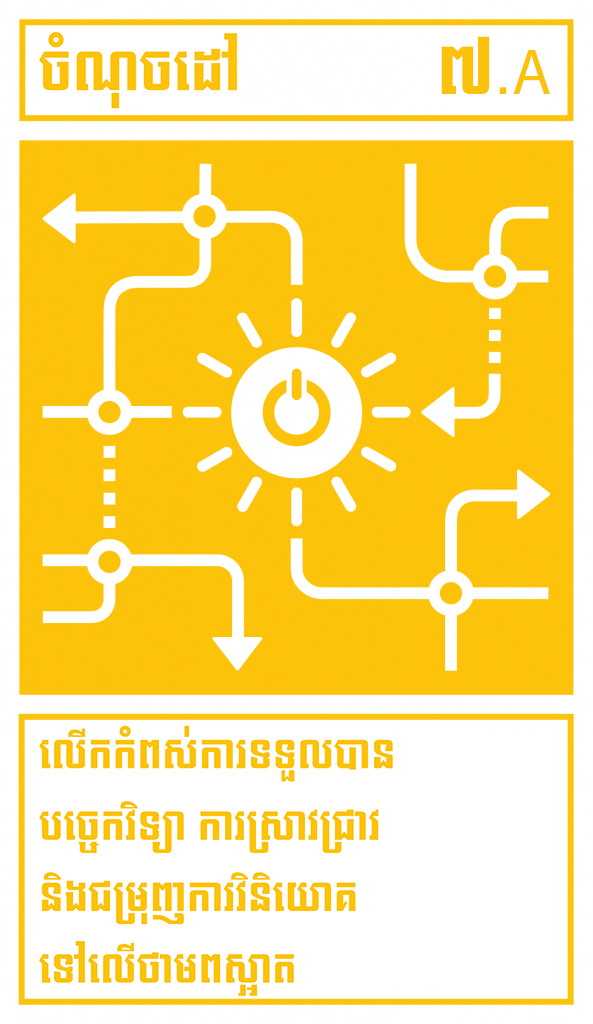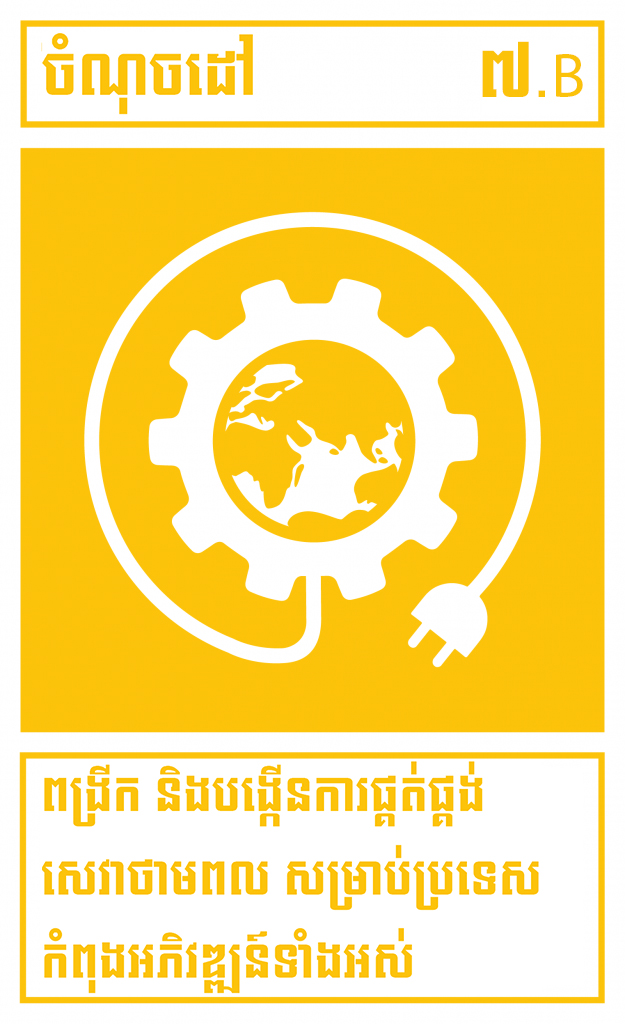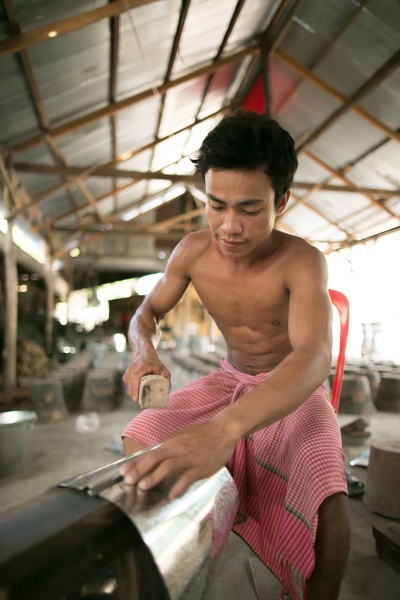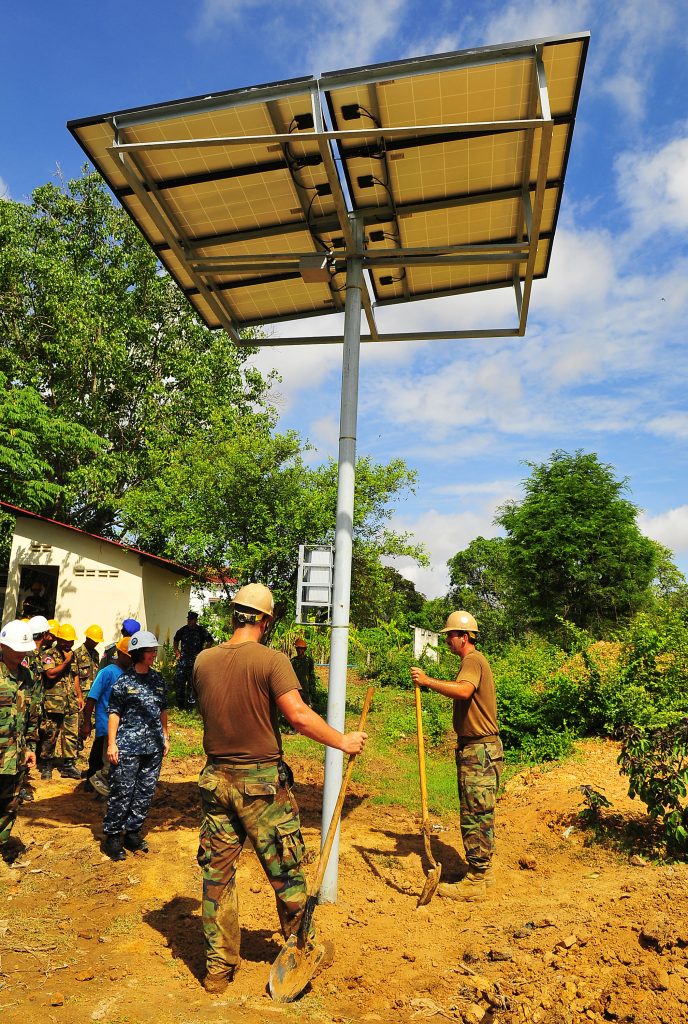គោលដៅអភិវឌ្ឍន៍ប្រកបដោយចីរភាពទី៧ ផ្តោតទៅលើការទទួលបានសេវាថាមពលទំនើបដែលមានតម្លៃសមរម្យ ទុកចិត្តបាន និងមាននិរន្តរភាព។ នេះរួមបញ្ជូលទាំងការធានានូវការទទួលបានជាសកលនូវសេវាថាមពលទំនើប អាចទុកចិត្តបាន និងតម្លៃសមរម្យ (គោលដៅទី៧.១) ការបង្កើនចំណែកនៃប្រភពថាមពលកកើតឡើងវិញ ដែលត្រូវបានប្រើសម្រាប់ផ្គត់ផ្គង់សេវាថាមពលទាំងនេះ (គោលដៅទី៧.២) និងការបង្កើនទ្វេរដងនៃអត្រាធ្វើឱ្យប្រសើរឡើងនូវប្រសិទ្ធិភាពថាមពលជាសកល (គោលដៅទី៧.៣)។1
ការទទួលបានថាមពល គឺមានសារៈសំខាន់ខ្លាំងណាស់ក្នុងការសម្រេចបាននូវស្ទើរតែទាំងស្រុងនៃគោលដៅអភិវឌ្ឍន៍ប្រកបដោយចីរភាពទាំងអស់ រាប់ចាប់តាំងពីតួនាទីនៅក្នុងការលុបបំបាត់នូវភាពក្រីក្រ តាមរយៈភាពកាន់តែល្អប្រសើរឡើងនៃសេវា សុខាភិបាល អប់រំ ផ្គត់ផ្គង់ទឹកស្អាត និងឧស្សាហកម្ម ដែលនឹងប្រយុទ្ធប្រឆាំងនឹងការប្រែប្រួលអាកាសធាតុ។2
  |   |  |
ថាមពលត្រូវបានពិពណ៌នាជាស្នូលដ៏សំខាន់ដើម្បីសម្រេចនូវរបៀបវារៈឆ្នាំ ២០៣០។ ក្រៅពីនេះ ដោយយោងតាមនិន្នាការនាពេលបច្ចុប្បន្ន នឹងមានមនុស្ស ២,៣ ពាន់លាននាក់នៅលើសកលលោក នឹងមិនអាចទទួលបាននូវបច្ចេកវិទ្យាចម្អិនអាហារស្អាត និងមានប្រសិទ្ធិភាព ដែលអាចការពារដល់បរិស្ថាន និងសុខភាពរបស់ពួកគេឡើយ។ ការដោះស្រាយជាបន្ទាន់នូវបញ្ហាទាំងនោះ នឹងត្រូវបានស្នើសុំ ដើម្បីឱ្យសម្រេចអោយបាននូវចំណុចដៅទាំងឡាយរបស់គោលដៅទី ៧ និងគោលដៅដទៃទៀតនៃគោលដៅអភិវឌ្ឍន៍ប្រកបដោយចីរភាព ជាពិសេសគោលដៅដែលទាក់ទងទៅនឹងការកាត់បន្ថយការប្រែប្រួលអាកាសធាតុ (ដូចជា គោលដៅទី ១៣)។
វិធីសាស្ត្រដោះស្រាយជាសកលដែលបានស្នើ គឺទាមទារឱ្យមានការប្រើប្រាស់មូលនិធិសាធារណៈដោយមានលក្ខណៈជាយុទ្ធសាស្ត្រ ដើម្បីជម្រុញលើកទឹកចិត្តកាន់តែខ្លាំងដល់ការវិនិយោគលើថាមពលកកើតឡើងវិញ និងបច្ចេកវិទ្យាថាមពលដែលមានប្រសិទ្ធិភាពនានា។ ជាពិសេស ការកសាងសមត្ថភាពនៅក្នុងស្រុក ដើម្បីគាំទ្រដល់ការវិនិយោគវិស័យឯកជនតាមរយៈការធ្វើវិមជ្ឈកាលហេដ្ឋារចនាសម្ព័ន្ធថាមពល ដែលត្រូវបានគេមើលឃើញថា ជាវិធីសាស្ត្រគន្លឹះ ដើម្បីអនុញ្ញាតឱ្យការទទួលបានសេវាថាមពលដោយសមភាព។ លើសពីនេះទៅទៀត វេទិកាកំពូលស្តីពីកិច្ចពិភាក្សានយោបាយដែលពិនិត្យលើគោលដៅទី៧ ក៏បានបញ្ជាក់នូវសារៈសំខាន់នៃកិច្ចសហប្រតិបត្តិការនៅក្នុងតំបន់ផងដែរ។3
ការផ្លាស់ប្តូរពីគោលដៅអភិវឌ្ឍន៍សហស្សវត្សរ៍ ទៅកាន់គោលដៅអភិវឌ្ឍន៍ប្រកបដោយចីរភាពទី៧ នៅក្នុងប្រទេសកម្ពុជា
គោលដៅអភិវឌ្ឍន៍សហស្សវត្សរ៍ពីមុន មិនមានការផ្តោតសំខាន់លើលទ្ធភាពទទួលបានថាមពលដែលមានសមភាពនោះទេ។ ចំណុច ៧.A សំដៅយ៉ាងទូលាយលើការណែនាំគោលការណ៍អភិវឌ្ឍន៍ប្រកបដោយចីរភាព ទៅក្នុងគោលនយោបាយជាតិ និងការផ្លាស់ប្តូរការបាត់បង់នៃធនធានបរិស្ថាន។ ចំណុចដៅ ៧.B ត្រូវបានផ្តោតទៅលើការកាត់បន្ថយការបាត់បង់ជីវចម្រុះ ដែលផ្នែកខ្លះនៃការកាត់បន្ថយនេះត្រូវបានធ្វើឡើង តាមរយៈសូចនាករមួយ ដើម្បីកាត់បន្ថយការបំភាយឧស្ម័នកាបូនឌីអុកស៊ីតទៅក្នុងបរិយាកាស។4 នៅពេលដែលចំណុចដៅទាំងនេះត្រូវបានធ្វើមូលដ្ឋានីយកម្មទៅក្នុងគោលដៅអភិវឌ្ឍន៍សហស្សវត្សរ៍កម្ពុជា វាត្រូវបានប្រែប្រួលក្នុងគោលដៅដើម្បីកាត់បន្ថយភាគរយនៃគ្រួសារដែលពឹងផ្អែកលើការប្រើប្រាស់អុសមកត្រឹម ៥២ ភាគរយនៅឆ្នាំ ២០១៥។5
នេះគឺជាសូចនាករថាមពលតែមួយគត់សម្រាប់គោលដៅអភិវឌ្ឍន៍សហស្សវត្សរ៍ ហើយនៅក្នុងឆ្នាំ ២០១៥ ការស្ទង់មតិសេដ្ឋកិច្ចសង្គមកម្ពុជា (CSES) បានបង្ហាញថា ៨២ ភាគរយនៃប្រជាជនកម្ពុជា នៅតែពឹងផ្អែកលើអុសដុត (៧៣,៩ភាគរយ) ឬធ្យូង (៨,១ភាគរយ) ជាប្រភពថាមពលចម្បងសម្រាប់ការចម្អិនម្ហូបអាហារ។6 នៅក្នុងឆ្នាំ ២០១៦ ផែនការយុទ្ធសាស្ដ្រ និងសកម្មភាពថ្នាក់ជាតិស្តីពីជីវៈចម្រុះ ដែលបានធ្វើឡើងឱ្យស្របទៅនឹងគោលដៅអភិវឌ្ឍន៍ប្រកបដោយចីរភាព បានកត់សម្គាល់ឃើញថា តម្រូវការនៃការប្រើប្រាស់អុសមានប្រមាណ ៧០ភាគរយនៃតម្រូវការថាមពលថ្នាក់ជាតិសរុប ហើយវាក៏ជាកត្តាចម្បងដែលនាំឱ្យមានការកាប់ព្រៃឈើផងដែរ ហើយជាលទ្ធផលនៃការប្រើប្រាស់អុសនេះ ក៏បានបង្កឱ្យការបំពុលខ្យល់ទាំងបរិយាកាសខាងក្នុង និងបរិយាកាសខាងក្រៅ ព្រមទាំងបង្កជាបញ្ហាបរិស្ថានផ្សេងទៀត។7

បុរសម្នាក់កំពុងផលិតចង្ក្រានដែលមានលក្ខណៈប្រសើរជាងមុននៅក្នុងប្រទេសកម្ពុជា។ រូបភាព ដោយ Sheepad, ថតនៅថ្ងៃទី១៧ ខែធ្នូ ឆ្នាំ ២០១៣។ ក្រោមអាជ្ញាប័ណ្ណ CC BY-SA 3.0។
ពេលដែលមូលដ្ឋានីយកម្មសូចនាករគោលដៅអភិវឌ្ឍន៍ប្រកបដោយចីរភាពត្រូវបានចេញផ្សាយនៅក្នុងចុងឆ្នាំ ២០១៨ ប្រទេសកម្ពុជាទំនងជានឹងប្រើប្រាស់សូចនាករទាំងនោះ ដើម្បីផ្តោតសំខាន់ទៅលើយុទ្ធសាស្ត្រសកម្មនានា ដើម្បីធ្វើឱ្យចេញជាលទ្ធផល។ សូចនាករជាសកលនៃគោលដៅអភិវឌ្ឍន៍ប្រកបដោយចីរភាពទី៧ រួមមាន៖
- ការបង្កើនសមាមាត្រនៃប្រជាជនដែលទទួលបានអគ្គិសនីប្រើប្រាស់ (សូចនាករ ៧.១.១) ជាមួយនឹងការជម្រុញប្រជាជនឱ្យពឹងផ្អែកលើឥន្ធនៈ និងបច្ចេកវិទ្យាស្អាតកាន់តែច្រើនជាងមុន (សូចនាករ ៧.១.២)
- ការបង្កើនចំណែកនៃប្រភពថាមពលកកើតឡើងវិញដែលបានប្រើប្រាស់ហើយ(សូចនាករ ៧.២.១)
- ការកាត់បន្ថយអាំងតង់ស៊ីតេនៃការប្រើប្រាស់ថាមពលជាទូទៅ ក៏ដូចជានៅក្នុងលក្ខខ័ណ្ឌនៃផលិតផលក្នុងស្រុកសរុប (សូចនាករ ៧.៣.១)។
ការទទួលបានអគ្គិសនីប្រើប្រាស់នៅក្នុងប្រទេសកម្ពុជា បានកើនឡើងជាលំដាប់ ចាប់តាំងពីអំឡុងទស្សវត្ស ១៩៩០ មក។8 យ៉ាងណាមិញ នៅឆ្នាំ ២០០៩ ខណៈពេលដែលអត្រានៃការទទួលបានអគ្គិសនីប្រើប្រាស់នៅកម្រិតទូទាំងប្រទេសបានឡើងដល់កម្រិត ៣៤,៤ ភាគរយ អត្រានៃអគ្គិសនីភាវូនីយកម្មបណ្តាញជាតិសមមូលមានកម្រិតត្រឹមតែប្រមាណ ១៥ ភាគរយប៉ុណ្ណោះ ហើយត្រូវបានផ្គត់ផ្គង់ជាចម្បងសម្រាប់គ្រួសារនៅក្នុងទីក្រុង (បានចំនួន ៥៥ ភាគរយ) បើប្រៀបធៀបទៅនឹងគ្រួសារនៅជនបទ (មានត្រឹមតែ ៥ ភាគរយ)។9
តម្រូវការសម្រាប់ការផ្តោតសំខាន់ទៅលើថាមពលកកើតឡើងវិញ ដែលប្រកបដោយនិរន្តរភាព នៅក្នុងថាមពលចម្រុះថ្នាក់ជាតិកាន់តែខ្លាំងឡើង។10 ខណៈពេលដែលគ្រួសារមួយចំនួននៅក្នុងប្រទេសកម្ពុជាអាចតភ្ជាប់ទៅនឹងបណ្តាញផ្គត់ផ្គង់អគ្គិសនីកណ្តាលមួយ ដែលអាចជឿទុកចិត្តបាន តែវាមិនមែនមានន័យថា នៅទូទាំងនៃប្រទេសកម្ពុជាសុទ្ធតែទទួលបានការផ្គត់ផ្គង់ដូចនេះទាំងអស់នោះទេ។ កាលណាជីវឥន្ធនៈ ឧស្ម័នធម្មជាតិ និងប្រេងឥន្ធនៈផ្សេងទៀត ត្រូវបានប្រើប្រាស់សម្រាប់ការចម្អិនម្ហូបអាហារ និងសម្រាប់សកម្មភាពគ្រួសារផ្សេងទៀត ប្រភពទាំងនោះជាញឹកញាប់ គឺនៅតែមិនអាចផ្តល់ការផ្គត់ផ្គង់ថាមពលដែលមានស្ថេរភាពប្រកបដោយនិរន្តរភាពបាននោះទេ។
ដើម្បីឆ្លើយតបទៅនឹងតម្រូវការនេះ អនុសញ្ញាផលិតកម្មអគ្គិសនីត្រូវបានអនុម័ត ដែលភាគច្រើនតាមរយៈការបង្កើតវារីអគ្គិសនីខ្នាតធំ ឬរោងចក្រអគ្គិសនីដើរដោយចំហេះធ្យូងថ្ម។11 រោងចក្រអគ្គិសនីដើរដោយចំហេះធ្យូងថ្ម មានប្រសិទ្ធិភាពច្រើនគួរសមក្នុងការកាត់បន្ថយភាគរយនៃការប្រើប្រាស់ថាមពលពីប្រភពកកើតឡើងវិញផ្សេងទៀត។
ការធ្វើមូលដ្ឋានីយកម្មគោលដៅទី៧ នៅក្នុងប្រទេសកម្ពុជា
ក្រសួងរ៉ែ និងថាមពល (MOME) មានតួនាទីទទួលខុសត្រូវចម្បងក្នុងការអនុវត្តគោលដៅអភិវឌ្ឍន៍ប្រកបដោយចីរភាពទី ៧ នៅក្នុងប្រទេសកម្ពុជា។ នៅឆ្នាំ ២០១៦ ការសិក្សារវាយតម្លៃលើការរួមបញ្ចូលយ៉ាងឆាប់រហ័ស បានរកឃើញថា គោលដៅអភិវឌ្ឍន៍ប្រកបដោយចីរភាពទី ៧ ត្រូវបានធ្វើឡើងស្របទៅនឹងគោលនយោបាយជាតិរបស់ប្រទេសកម្ពុជារួចទៅហើយ។12 គោលនយោបាយជាតិទាំងនោះរួមមាន ផែនការយុទ្ធសាស្ដ្រអភិវឌ្ឍន៍ជាតិ (២០១៤-២០១៨) ដែលបានបន្តការអនុវត្តផែនការអភិវឌ្ឍន៍វិស័យថាមពល (២០០៥-២០២៤) ព្រមទាំងផែនការមេស្តីពីអគ្គិសនីភាវូបនីយកម្មជនបទ (REMP) ឆ្នាំ២០០៣ និងផែនការសកម្មភាពស្តីពីថាមពលកកើតឡើងវិញ (REAP) ឆ្នាំ២០០៣ ផងដែរ។13
ជាឧទាហរណ៍៖
- សម្រាប់ចំណុចដៅ ៧.១ នៃគោលដៅអភិវឌ្ឍន៍ប្រកបដោយចីរភាព រាជរដ្ឋាភិបាលកម្ពុជា ទំនងជានឹងបន្តមហិច្ឆតារបស់ខ្លួនក្នុងការផ្តល់ឱ្យបាននូវការទទួលបានអគ្គិសនីប្រើប្រាស់មិនថាក្នុងទម្រង់ប្រភេទណាមួយ (រួមទាំងអាគុយ) អោយបាន ១០០ ភាគរយ នៃភូមិទាំងអស់ នៅត្រឹមឆ្នាំ២០២០ ដោយបង្កើនពីចំនួន ៦២ ភាគរយនៃភូមិទាំងអស់ក្នុងភូមិនៅឆ្នាំ ២០១៥14 និងយ៉ាងហោចណាស់ ៧០ ភាគរយនៃគ្រួសារទាំងអស់ អាចភ្ជាប់ទៅនឹងបណ្តាញជាតិដែលមានគុណភាព នៅត្រឹមឆ្នាំ ២០៣០។15
- ខណៈពេលដែលប្រទេសកម្ពុជាមិនទាន់បានកំណត់នូវចំណុចដៅមូលដ្ឋានីយកម្ម ៧.២ នៃគោលដៅអភិវឌ្ឍន៍ប្រកបដោយចីរភាពនៅឡើយ អង្គការមូលនិធិសកលសម្រាប់អភិរក្សធនធានធម្មជាតិ (WWF) បានគូសបញ្ជាក់ពីសក្តានុពលនៃ “សេណារីយ៉ូថាមពលប្រកបដោយនិរន្តរភាព” មួយសម្រាប់ប្រទេសកម្ពុជា។ សេណារីយ៉ូនេះបានបង្ហាញថា វាអាចធ្វើទៅបានតាមលក្ខណៈបច្ចេកទេសក្នុងការផ្គត់ផ្គង់អគ្គិសនីដល់ប្រជាជនគ្រប់គ្នាជាមួយនឹងអត្រា ១០០ ភាគរយនៃថាមពលដែលពួកគេត្រូវការ និងប្រមាណ ៩០ ភាគរយទៀត ដែលបានមកពីប្រភពកកើតឡើងវិញ។ ការវិភាគបែបនេះប្រហែលនឹងអាចមានឥទ្ធិពលលើគោលដៅដែលរាជរដ្ឋាភិបាលកម្ពុជាកំណត់សម្រាប់ឆ្នាំ ២០៣០។16
- ជាថ្មីម្តងទៀត ខណៈពេលដែលមូលដ្ឋានីយកម្មសម្រាប់ចំណុចដៅ ៧.៣ នៃគោលដៅអភិវឌ្ឍន៍ប្រកបដោយចីរភាពមិនទាន់បានកំណត់នៅឡើយ ប្រទេសកម្ពុជានៅតែមានសក្តានុពលយ៉ាងសំខាន់ដើម្បីបង្កើនប្រសិទ្ធភាពថាមពលយ៉ាងឆាប់រហ័សនៅក្នុងប្រទេសរបស់ខ្លួន។ ជាឧទាហរណ៍ ក្នុងឆ្នាំ ២០១៣ សេចក្តីព្រាងគោលនយោបាយជាតិមួយ ស្តីពីយុទ្ធសាស្ត្រ និងផែនការសកម្មភាពប្រសិទ្ធភាពថាមពល (ស្ថាប័នសម្របសម្រួលកិច្ចផ្តួចផ្តើមសន្ទនាភាពជាដៃគូថាមពលរបស់សហភាពអឺរ៉ុប) បានបង្កើតនូវគោលដៅរួមមួយនៃការកាត់បន្ថយតម្រូវការថាមពលជាតិអោយបានត្រឹម ២០ ភាគរយ នៅឆ្នាំ២០៣៥ បើប្រៀបធៀបទៅនឹងអាជីវកម្មដូចធម្មតា (BAU) ដោយមានគោលដៅនៃការកាត់បន្ថយជាទូទៅ ១០ ភាគរយនៅក្នុងវិស័យនីមួយៗនៅត្រឹមឆ្នាំ ២០៣០។17
មធ្យោបាយនៃការអនុវត្តគោលដៅអភិវឌ្ឍន៍ប្រកបដោយចីរភាពទី៧ នៅក្នុងប្រទេសកម្ពុជា
មានមធ្យោបាយនៃការអភិវឌ្ឍសូចនាករសម្រាប់គោលដៅអភិវឌ្ឍន៍ប្រកបដោយចីរភាពទី៧ ចំនួនពីរ ដែលនឹងគាំទ្រដល់ប្រទេសកម្ពុជា ក្នុងនាមជាប្រទេសអភិវឌ្ឍន៍តិចតួច ដើម្បីចូលដំណើរការធនធាន និងបច្ចេកវិទ្យាដែលតម្រូវឱ្យប្រទេសនេះសម្រេចដល់ចំណុចដៅ។ មធ្យោបាយទាំងនោះពាក់ព័ន្ធទៅនឹងការ៖
- ធ្វើឱ្យប្រសើរឡើងកិច្ចសហប្រតិបត្តិការអន្តរជាតិលើកិច្ចការស្រាវជ្រាវថាមពលស្អាត និងការអភិវឌ្ឍបច្ចេកវិទ្យា ជាពិសេសនៅក្នុងផ្នែកនៃថាមពលកកើតឡើងវិញ និងការលើកកម្ពស់ដល់ការវិនិយោគហេដ្ឋារចនាសម្ព័ន្ធថាមពល និងបច្ចេកវិទ្យាថាមពលស្អាត (ចំណុចដៅ ៧.A)
- ការវិនិយោគនៅក្នុងហេដ្ឋារចនាសម្ព័ន្ធ និងបច្ចេកវិទ្យា ដើម្បីគាំទ្រដល់ទំនើបភាព សេវាថាមពលដែលមាននិរន្តរភាពសម្រាប់បណ្តាប្រទេសកំពុងអភិវឌ្ឍន៍ដូចជាប្រទេសកម្ពុជា (ចំណុចដៅ ៧.B)។
បច្ចុប្បន្ននេះ កម្មវិធីអគ្គិសនីភាវូបនីយកម្មនៅក្នុងប្រទេសកម្ពុជា ភាគច្រើនជាខ្នាតធំ និងត្រូវបានសម្របសម្រួលជាកណ្តាល និងត្រូវបានធ្វើផែនការដោយសហគ្រាសគ្រប់គ្រងដោយរដ្ឋមួយដែលមានឈ្មោះថា អគ្គិសនីកម្ពុជា (EDC) នៅក្នុងតម្លៃមួយដែលប្រជាជនមិនមានលទ្ធភាពប្រើប្រាស់បាននៅគ្រប់តំបន់នៅក្នុងប្រទេសកម្ពុជា។ ដើម្បីសម្រេចបាននូវចំណុចដៅទាំងឡាយនៃគោលដៅអភិវឌ្ឍន៍ប្រកបដោយចីរភាពទី៧ វាពិតជាសំខាន់ណាស់ដើម្បីទាក់ទាញការវិនិយោគលើហេដ្ឋារចនាសម្ព័ន្ធ និងបច្ចេកវិទ្យាសមស្របសម្រាប់សហគ្រាសអគ្គិសនីតាមទីជនបទ ដូចជាបណ្តាញបញ្ជូនរង បណ្តាញទោលតូចៗ និងប្រព័ន្ធផ្គត់ផ្គង់ដោយឡែក។18

ក្រុមការងារដៃគូក្នុងតំបន់កំពុងតំឡើងប្រព័ន្ធថាមពលពន្លឺព្រះអាទិត្យដែលជាប្រព័ន្ធផ្គត់ផ្គង់ដោយឡែកនៅចំបក់ ខេត្តកំពង់ស្ពឺ ប្រទេសកម្ពុជា។ រូបភាព ដោយក្រុមអ្នកឯកទេសផ្នែកទំនាក់ទំនងកងទ័ពជើងទឹក កម្រិតថ្នាក់ទី២ លោក Jon Husman, ថតនៅថ្ងៃទី២៣ ខែ មិថុនា ឆ្នាំ២០១០។ ក្រោមអាជ្ញាប័ណ្ណ Wikimedia Commons។
ហានិភ័យនៃការវិនិយោគទាំងនេះនឹងទាមទារឱ្យមានការគ្រប់គ្រងដោយមានយន្ដការហិរញ្ញវត្ថុជាច្រើនដែលលើកទឹកចិត្តដល់ការវិនិយោគវិស័យឯកជន ខណៈពេលដែលអគ្គិសនីកម្ពុជានៅតែកំពុងអភិវឌ្ឍសមត្ថភាពរបស់ខ្លួនដើម្បីផ្គត់ផ្គង់អគ្គិសនីដល់គ្រប់ប្រជាពលរដ្ឋទាំងអស់នៅក្នុងប្រទេសកម្ពុជា។ ការនេះនឹងពាក់ព័ន្ធទៅនឹងទំហំនៃការវិនិយោគ ដើម្បីសម្រេចបានគោលដៅអគ្គិសនីភាវូបនីយកម្មជនបទ ដែលបានកំណត់ថា នៅត្រឹមឆ្នាំ ២០៣០ ប្រជាជននៅតាមទីជនបទប្រមាណ ១០០.០០០ គ្រួសារជារៀងរាល់ឆ្នាំ ឬ ជាសរុបចំនួន ២,១ លានគ្រួសារនៅតាមជនបទក្នុងអំឡុងពេលនៃការអនុវត្តគោលដៅអភិវឌ្ឍន៍ប្រកបដោយចីរភាព។19
ការវិនិយោគទៅលើជម្រើសនៃការអភិវឌ្ឍបច្ចេកវិទ្យា ដូចជា ការបម្លែងថាមពលព្រះអាទិត្យ ថាមពលវារីអគ្គិសនីខ្នាតតូច និងមីក្រូ ទំនងជានឹងត្រូវបានពង្រីកអានុភាព ដោយបង្កើនកម្រិតនៃការផ្តល់មូលនិធិសាធារណៈ និងកិច្ចសហប្រតិបត្តិការជាមួយយន្តការអន្តរជាតិនានា មានដូចជា មជ្ឈមណ្ឌលថាមពលអាស៊ាន ទីភ្នាក់ងារថាមពលអន្តរជាតិ (IEA) និងមូលនិធិអង្គការសហប្រជាជាតិអាកាសធាតុបៃតង។20
ការត្រួតពិនិត្យគោលដៅអភិវឌ្ឍន៍ប្រកបដោយចីរភាពទី៧ នៅក្នុងប្រទេសកម្ពុជា
ការផ្តោតសំខាន់នៃចំណុចដៅរបស់គោលដៅអភិវឌ្ឍន៍ប្រកបដោយចីរភាពនៅក្នុងប្រទេសកម្ពុជា គឺការពង្រីកផែនការអគ្គិសនីភាវូបនីយកម្មជនបទ និងលទ្ធភាពទទួលបានអគ្គិសនីបណ្តាញជាតិប្រើប្រាស់។ ការនេះនឹងបង្កើតជាស្នូលយ៉ាងសំខាន់នៃការត្រួតពិនិត្យ និងវាយតម្លៃដំណើរការសម្រាប់គោលដៅទី៧នេះ នៅក្នុងប្រទេសកម្ពុជា។21
អំឡុងពេលពីពេលនេះរហូតដល់ឆ្នាំ ២០៣០ ការប្រមូល និងការវិភាគទិន្នន័យដែលទាន់ពេលវេលា នឹងត្រូវបានប្រើប្រាស់ជាប្រយោជន៍សម្រាប់ការអនុញ្ញាតឱ្យមានការបង្កើតការវិនិយោគវ័យឆ្លាត ដើម្បីជម្រុញដល់ការវិនិយោគនានា ដែលអាចនឹងប្រែក្លាយរបៀបនៃការប្រើប្រាស់ថាមពលរបស់ប្រជាជននៅទីជនបទបាន។ ការវិវត្តនៃដំណើរការចាំបាច់ត្រូវតែបង្កើនសមភាពពីរបៀបដែលថាមពលត្រូវបានផលិត និងចែកចាយ។ ជាពិសេសទិន្នន័យដែលប្រមូលបានសម្រាប់គោលដៅអភិវឌ្ឍន៍ប្រកបដោយចីរភាពទី៧ នឹងក្លាយជាគោលដៅសំខាន់សម្រាប់ការអភិវឌ្ឍចំណុចដៅរួមបញ្ជូលគ្នាបន្ថែមទៀត ដើម្បីធ្វើការវាយតម្លៃហេតុប៉ះពាល់នៃគោលនយោបាយលើកកម្ពស់វារីអគ្គិសនីខ្នាតធំ ឱ្យរួមមានហេតុប៉ះពាល់សង្គមនៅផ្នែកខ្សែទឹកខាងលើ និងខ្សែទឹកខាងក្រោម ឱ្យបានកាន់តែប្រសើរឡើង។22
ប្រធានបទពាក់ព័ន្ធ
- គោលដៅអភិវឌ្ឍន៍ប្រកបដោយចីរភាព
- ទំនប់វារីអគ្គិសនី
- គោលនយោបាយ និងការគ្រប់គ្រងថាមពល
- ផលិតកម្មថាមពលកកើតឡើងវិញ
- ឥន្ធនៈសម្រាប់ចម្អិនអាហារ
ឯកសារយោង
- 1. «ការលើកកម្ពស់ការកសាងសមត្ថភាពសម្រាប់គោលដៅអភិវឌ្ឍន៍ប្រកបដោយចីរភាពទី៧,» កម្មវិធីអភិវឌ្ឍន៍សហប្រជាជាតិ (UNDP), ចូលអានខែកញ្ញា ឆ្នាំ ២០១៨។
- 2. «គោលដៅអភិវឌ្ឍន៍ប្រកបដោយចីរភាពទី៧,» វេទិកាចំណេះដឹងនៃការអភិវឌ្ឍប្រកបដោយចីរភាព (Sustainable Development Knowledge Platform), ចូលអានខែកញ្ញា ឆ្នាំ២០១៨។
- 3. អង្គការសហប្រជាជាតិ, «សមិទ្ធិផលនៃការពន្លឿនគោលដៅអភិវឌ្ឍប្រកបដោយចីរភាពទី ៧៖ សង្ខេបគោលនយោបាយក្នុងការគាំទ្រនៃការពិនិត្យដំបូងលើគោលដៅអភិវឌ្ឍន៍ដោយចីរភាពទី៧ នៅឯវេទិកានយោបាយកំពូលរបស់អង្គការសហប្រជាជាតិឆ្នាំ២០១៨,» វេទិកាចំណេះដឹងនៃការអភិវឌ្ឍប្រកបដោយចីរភាពរបស់អង្គការសហប្រជាជាតិ, ចូលអានខែកញ្ញា ឆ្នាំ ២០១៨។
- 4. «ចំណុចដៅ និងសូចនាករនៃគោលដៅអភិវឌ្ឍន៍សហសវត្សរ៍,» UN NGLS, ចូលអានខែកញ្ញា ឆ្នាំ២០១៨។
- 5. រាជរដ្ឋាភិបាលកម្ពុជា, «ការសម្រេចបាននូវគោលដៅអភិវឌ្ឍន៍សហស្សវត្សរ៍របស់កម្ពុជា៖ ធ្វើបច្ចុប្បន្នភាពឆ្នាំ ២០១០,» ចូលអានខែកញ្ញា ឆ្នាំ ២០១៨។
- 6. វិទ្យាស្ថានជាតិស្ថិតិ, «ការស្ទង់មតិសង្គមសេដ្ឋកិច្ចកម្ពុជាឆ្នាំ ២០១៥,» រាជធានីភ្នំពេញ, ខែតុលា ឆ្នាំ ២០១៦។ ចូលអានខែកញ្ញា ឆ្នាំ ២០១៨។
- 7. ក្រុមប្រឹក្សាជាតិអភិវឌ្ឍន៍ដោយចីរភាព, «ផែនការសកម្មភាព និងយុទ្ធសាស្ត្រជីវចម្រុះជាតិ ឆ្នាំ២០១៦,» ខែកុម្ភៈ ឆ្នាំ២០១៦។ ចូលអានខែកញ្ញា ឆ្នាំ២០១៨។
- 8. «ការទទួលបានអគ្គិសនីប្រើប្រាស់(ជាភាគរយនៃប្រជាជនសរុប),» ទិន្នន័យបើកទូលាយរបស់ធនាគារពិភពលោក, ចូលអានខែកញ្ញា ឆ្នាំ២០១៨។
- 9. ធនាគារពិភពលោក, «របាយការណ៍ចុងក្រោយស្តីពីផែនការយុទ្ធសាស្ត្រ និងការអនុវត្តអគ្គិសនីភាវូបនីយកម្មជនបទប្រទេសកម្ពុជា,» ថ្ងៃទី៣១ ខែធ្នូ ឆ្នាំ ២០០៩, ចូលអានខែកញ្ញា ឆ្នាំ ២០១៨។
- 10. អង្គការមូលនិធិសកលសម្រាប់អភិរក្សធនធានធម្មជាតិ (WWF), «ចក្ខុវិស័យលើវិស័យថាមពល៖ ដំណើរឆ្ពោះទៅកាន់ថាមពលកកើតឡើងវិញឱ្យបាន ១០០ ភាគរយនៅក្នុងឆ្នាំ ២០៥០ មហាតំបន់មេគង្គ-របាយការណ៍ប្រទេសកម្ពុជា,» ២០១៦, ចូលអានខែកញ្ញា ឆ្នាំ២០១៨។
- 11. ក្រសួងរ៉ែ និងថាមពល និងវិទ្យាស្ថានស្រាវជ្រាវសេដ្ឋកិច្ចសម្រាប់តំបន់អាស៊ាន និងអាស៊ីបូព៌ា, «ស្ថិតិថាមពលជាតិរបស់ប្រទេសកម្ពុជាឆ្នាំ ២០១៦,» ចូលអានខែកញ្ញា ឆ្នាំ ២០១៨។
- 12. កម្មវិធីអភិវឌ្ឍនៃអង្គការសហប្រជាជាតិ (UNDP), «ការវាយតម្លៃរួមបញ្ចូលគ្នាឆាប់រហ័ស - គោលដៅអភិវឌ្ឍន៍ប្រកបដោយចីរភាពនៅកម្ពុជា,» (អង្គការសហប្រជាជាតិប្រចាំនៅកម្ពុជា)។ ចូលអានខែកញ្ញា ឆ្នាំ២០១៨។
- 13. Poch, K. (២០១៣), «ការអភិវឌ្ឍថាមពលកកើតឡើងវិញនៅក្នុងប្រទេសកម្ពុជា៖ ស្ថានភាព ទស្សនៈវិស័យ និងគោលនយោបាយ,» in Kimura, S., H. Phoumin និង B. Jacobs (eds.), សមាហរណកម្មទីផ្សារថាមពលនៅក្នុងតំបន់អាស៊ីបូព៌ា៖ ថាមពលកកើតឡើងវិញ និងការដាក់ឱ្យដំណើរការរបស់វាទៅក្នុងប្រព័ន្ធថាមពល, របាយការណ៍គម្រោងស្រាវជ្រាវរបស់ ERIA ២០១២-២៦, ទីក្រុងចាកាតា៖ ERIA។ ទំព័រ ២២៧-២៦៦។ ចូលអានខែកញ្ញា ឆ្នាំ ២០១៨។
- 14. អង្គការមូលនិធិសកលសម្រាប់អភិរក្សធនធានធម្មជាតិ (WWF), «ចក្ខុវិស័យលើវិស័យថាមពល៖ ដំណើរឆ្ពោះទៅកាន់ថាមពលកកើតឡើងវិញឱ្យបាន ១០០ ភាគរយនៅក្នុងឆ្នាំ ២០៥០ មហាតំបន់មេគង្គ-របាយការណ៍ប្រទេសកម្ពុជា,» ២០១៦, ចូលអានខែកញ្ញា ឆ្នាំ២០១៨។
- 15. «ការទទួលបានការប្រើប្រាស់ថាមពលជាសកលនៅក្នុងតំបន់អាស៊ាន៖ ករណីប្រទេសកម្ពុជា និងសាធារណរដ្ឋប្រជាមានិតឡាវ,» មជ្ឈមណ្ឌលអាស៊ានសម្រាប់វិស័យថាមពល, ២០១៦។ ចូលអានខែកញ្ញា ឆ្នាំ ២០១៨។
- 16. អង្គការមូលនិធិសកលសម្រាប់អភិរក្សធនធានធម្មជាតិ (WWF)។ «ចក្ខុវិស័យលើវិស័យថាមពល៖ ដំណើរឆ្ពោះទៅកាន់ថាមពលកកើតឡើងវិញឱ្យបាន ១០០ ភាគរយនៅក្នុងឆ្នាំ ២០៥០ មហាតំបន់មេគង្គ-របាយការណ៍ប្រទេសកម្ពុជា,» ២០១៦, ចូលអានខែកញ្ញា ឆ្នាំ២០១៨។
- 17. ធនាគារអភិវឌ្ឍន៍អាស៊ី, «ការអភិវឌ្ឍប្រសិទ្ធិភាពថាមពល និងសក្តានុពលនៃការសន្សំសំចៃថាមពលនៅក្នុងមហាអនុតំបន់មេគង្គ,» ខែកក្កដា ឆ្នាំ ២០១៥។ ចូលអានខែកញ្ញា ឆ្នាំ ២០១៨។
- 18. ធនាគារពិភពលោក, «របាយការណ៍ចុងក្រោយស្តីពីផែនការយុទ្ធសាស្ត្រ និងការអនុវត្តអគ្គិសនីភាវូបនីយកម្មជនបទប្រទេសកម្ពុជា,» ថ្ងៃទី៣១ ខែធ្នូ ឆ្នាំ ២០០៩, ចូលអានខែកញ្ញា ឆ្នាំ ២០១៨។
- 19. ដូចឯកសារយោងខាងដើម។
- 20. ក្រសួងរ៉ែ និងថាមពល និងវិទ្យាស្ថានស្រាវជ្រាវសេដ្ឋកិច្ចសម្រាប់តំបន់អាស៊ាន និងអាស៊ីបូព៌ា, «ស្ថិតិថាមពលជាតិរបស់ប្រទេសកម្ពុជាឆ្នាំ ២០១៦,» ចូលអានខែកញ្ញា ឆ្នាំ ២០១៨។
- 21. ធនាគារអភិវឌ្ឍន៍អាស៊ី, «ការអភិវឌ្ឍប្រសិទ្ធិភាពថាមពល និងសក្តានុពលនៃការសន្សំសំចៃថាមពលនៅក្នុងមហាអនុតំបន់មេគង្គ,» ខែកក្កដា ឆ្នាំ ២០១៥។ ចូលអានខែកញ្ញា ឆ្នាំ ២០១៨។
- 22. អង្គការសហប្រជាជាតិ, «សមិទ្ធិផលនៃការពន្លឿនគោលដៅអភិវឌ្ឍប្រកបដោយចីរភាពទី ៧៖ សង្ខេបគោលនយោបាយក្នុងការគាំទ្រនៃការពិនិត្យដំបូងលើគោលដៅអភិវឌ្ឍន៍ដោយចីរភាពទី៧ នៅឯវេទិកានយោបាយកំពូលរបស់អង្គការសហប្រជាជាតិឆ្នាំ២០១៨,» វេទិកាចំណេះដឹងនៃការអភិវឌ្ឍប្រកបដោយចីរភាពរបស់អង្គការសហប្រជាជាតិ, ចូលអានខែកញ្ញា ឆ្នាំ ២០១៨។

